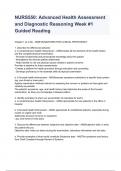NURS550: Advanced Health Assessment
and Diagnostic Reasoning Week #1
Guided Reading
Chapter 1 (p 4-34) - ANSFOUNDATIONS FOR CLINICAL PROFICIENCY
1. Describe the differences between
a. A comprehensive health history/exam - ANSIncludes all the elements of the health history
and the complete physical examination.
- Provides fundamental and personalized knowledge about the patient
- Strengthens the clinician-patient relationship
- Helps identify or rule out physical causes related to patient concerns
Provides a baseline for future assessments
-Creates a platform for health promotion through education and counseling
- Develops proficiency in the essential skills of physical examination
b. A focused health history/exam - ANSAssesses symptoms restricted to a specific body system
(eg. sore throat or knee pain)
Applies examination methods relevant to assessing the concern or problem as thoroughly and
carefully as possible
The patient's symptoms, age, and health history help determine the scope of the focused
examination, as does your knowledge of disease pattern
2. Identify examples of when you would obtain (2 examples for each):
a. A comprehensive health history/exam - ANSIs appropriate for new patients in the office or
hospital
b. A focused health history/exam - ANSIs appropriate for established patients, especially during
routine or urgent care visits
Addresses focused concerns or symptoms
( eg. sore throat or knee pain)
3. Discuss the differences between subjective and objective data - ANSSubjective data: is what
the patient tells you
Objective data: what you detect during the examination, laboratory information and test data
a. Provide examples of what would constitute Subjective data - ANSThe symptoms and history,
from Chief Complaint through Review of Systems
, Example: Mrs. G. is a 54-year-old hairdresser who reports pressure over her left chest "like an
elephant sitting there," which goes into her left neck and arm.
b. Provide examples of what would constitute Objective data - ANSAll physical examination
findings, or signs
Example: Mrs. G. is an older, overweight white female, who is pleasant and cooperative. Height
5′4′′, weight 150 lbs, BMI 26, BP 160/80, HR 96 and regular, respiratory rate 24, temperature
97.5 °F
4. Identify what goes into each section of the comprehensive health history
a. Identifying data and source of history - ANSIdentifying data—such as age, gender,
occupation, marital status
Source of the history—usually the patient, but can be a family member or friend, letter of
referral, or the clinical record
If appropriate, establish the source of referral, because a written report may be needed
b. Chief complaint - ANSThe one or more symptoms or concerns causing the patient to seek
care.
Note: make every attempt to quote the pt's own words. Eg. "my stomach hurts and I feel awful"
c. History of present illness - ANSIs a complete, clear, and chronologic description of the
problems prompting the patient's visit, including the onset of the problem, the setting in which it
developed, its manifestations, and any treatments to date.
Pulls in relevant portions of the Review of Systems, called "pertinent positives and negatives"
(see p. 11)
May include medications, allergies, and tobacco use and alcohol, which are frequently pertinent
to the present illness
d Past history - ANSLists childhood illnesses
Lists adult illnesses with dates for events in at least four categories: medical, surgical, ob/gyn, &
psychiatric Includes health maintenance practices such as immunizations, screening tests,
lifestyle issues, and home safety
e. Family history - ANSOutlines or diagrams age and health, or age and cause of death, of
siblings, parents, and grandparents
Documents presence or absence of specific illnesses in family, such as hypertension, diabetes,
or type of cancer
f. Personal and social history - ANS- Describes educational level, family of origin, current
household, personal interests, and lifestyle.
- occupation & health promotion
- hx of tobacco, drug & alcohol use.
(Health Promotion/Maintenance Activities: screenings, immunizations, sleep, exercise




